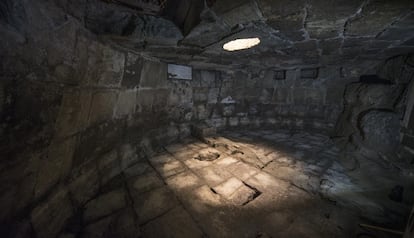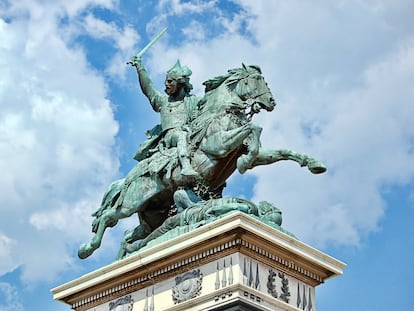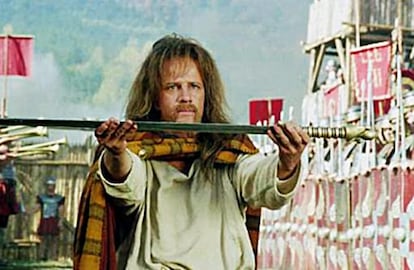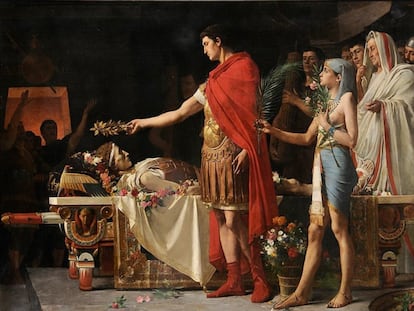
‘Caesar’s Prisoner’: The thrilling story of the Gallic rebel Vercingetorix, his Roman guard and the notorious dungeons of Mamertine
Novelist Massimiliano Colombo takes EL PAÍS on a tour of the Tullianum, the infamous underground prison where the warrior chief of Gaul languished for years awaiting execution, and now, the main setting of a magnificent new historical novel
It’s is a perfectly gray and rainy day to tour one of the most sinister and inhospitable historical sites in all of Rome: Mamertine Prison. Early in the morning, hardly a soul is visiting the Forum. The ancient ruins exhale a dark energy — an aura of power and mystery. In the distance, Trajan’s Column rises up among the pines, and farther off, the Colosseum reveals a portion of its imposing profile. Near the Arch of Septimius Severus and the Temple of Saturn, with its six cold marble fingers, in an open, cobbled square at the end of the ancient Roman road of Clivus Argentarius (“Sloping Street”), stands the 17th-century Baroque church of San Giuseppe dei Falegnami (St. Joseph of the Carpenters). On the church’s first floor, written in large metal letters on the lintel above the entrance, is the word “Mamertinum.” The church was built on top of Ancient Rome’s most infamous prison, Mamertine, in whose bowels lay the notorious dungeons of Tullianum: a space made of two chambers, the lowest of which (the chamber typically refered to as the Tullianum, or Tullus) consisting of a terrible, disgusting, claustrophobic subterranean pit where the worst enemies of Rome were locked away to await their executions (the Romans did not apply the penalty of imprisonment).
One of the most illustrious prisoners to ever languish in that place of nightmares and condemnation — accessible only through a small hole in the floor of the upper room — was the Gallic king and rebel Vercingetorix, the leader of the revolt that was defeated in 52 BC in Alesia by the armies of Julius Caesar. We know very little about Vercingetorix, who is perhaps best known for his portrayal in the French comic book series The Adventures of Asterix, where he is depicted surrendering to Caesar and throwing his weapons before the feet of the Roman general. The real story is far less comical than the version illustrated by Uderzo and Goscinny (just as the Gallic War, which bathed the province in blood, was not funny at all): the defeated Vercingetorix was taken captive and sent to Rome, where he waited five and a half years in prison, until 46 BC, to finally be paraded in Caesar’s triumph (triumphus) — the famous victory procession of the Roman generals — to face immediate ritual execution during a celebratory feast.
Legend has it that the Gallic warlord and king of the Arverni people spent the time between his surrender and execution confined in the Tullianum. Now, a magnificent historical novel, Il prigioniero di Cesare — “Caesar’s Prisoner”, not yet translated to English, but available in Spanish as El prisionero del César (Ediciones B, 2023) — by Massimiliano Colombo, the acclaimed author of The Legion of the Immortals, Draco, Centurio, Devoto, and several other books in the genre, imagines what those miserable years in Rome’s infamous dungeon might have been like. The author centers his gripping and moving account around the Gallic rebel’s years of imprisonment, and the two protagonists are Vercingetorix himself — whom Colombo rescues from the shadows of history, interspersed the narrative with moments of intense flashback, to scenes such as the rebel king’s surrender in Alesia — and the seasoned veteran and chief centurion, or primus pilus, of Caesar’s legions, Publius Sextius Bacchus, who is charged with guarding the prisoner. Although Colombo’s account of Baccus’s position as guard is fictitious, the centurion is a real historical figure, mentioned three times in Caesar’s firsthand account of the Gallic Wars, Commentaries on the Gallic War, where he is remembered for his heroism in defending the gate to the garrison of Atuatuca against a party of Sicambri warriors, despite his convalescence.

Massimiliano Colombo (Bergamo, Italy, 56 years old) suggests that we meet at the very place at the center of his novel, and the truth is that, after having read it, it’s hard not to feel pangs of anxiety at the prospect of going down there, into that dark pit that put fear in the hearts of some of antiquity’s bravest men. The writer, who served in the Italian Army’s “Folgore” Paratroopers Brigade — an experience reflected in the realism with which he narrates the novel’s military scenes (although obviously the Roman legions had no airborne troops) — is waiting for me in front of the church that sits above the old prison, and there’s no mistaking him: Although he now works as a security systems consultant, he still looks like a soldier and still wears a military jacket with the insignia of his former unit (a bird and a lightning bolt). He smiles when I greet him with the phrase “manco la fortuna non il valore” (“we were short on luck, not bravery”), in memory of the former Folgore and other Italian troops who fought bravely in the Battle of El Alamein in WWII. Colombo has a sympathetic and determined attitude (he emphasizes that he commanded an assault squadron, not a kitchen or infirmary), and he quickly jumps into a guided tour of the novel’s topography: here is where Vercingetorix was paraded for Caesar’s triumph; there are the Gemonian Stairs (the Stairs of Mourning, a site of Roman executions) and the Temple of Jupiter Capitolinus, where Caesar ends his triumph and steps down from his chariot; that’s the street where the naked body of the Gallic king, following his execution, in which he is strangled in a terrible scene of torture, is ruthlessly dragged through the city by a hook, to be dumped in the Tiber River.
After purchasing two tickets at the entrance, Colombo leads us to the first room in the museum, where we find a display consisting of a small exhibition of archaeological material found on site, a series of scale models, and an audiovisual presentation. A modern metal staircase leads down a narrow passageway to the upper room of the Tullianum, in the center of which lies the dark hole that in ancient times served as the only access to the well of the condemned, which before being converted into a dungeon, had probably been used as a cistern. The novelist crouches to look down the dark hole, just as the Roman centurion does so many times in his book. Perhaps he can hear the echos of Vercingetorix’s death wails… Then, we go down one more level via another narrow staircase, to the dark heart of the place: a cold circular dungeon of damp, gloomy stone, with a foul atmosphere resembling a stone cave.

It is astonishing to think that Vercingetorix, who, like Colombo, was probably quite large, tall and strong (this, at least, is how he is described in the novel: in reality, we only have a few depictions from some old Roman coins, like the staters from Puy de Dôme), could have spent almost six years in this place, on the verge of death, languishing in loneliness, shame and the painful memory of lost opportunities. “Imagine what it would have been like,” muses Colombo. “When I first saw the site, I knew I had to write about it.” We spend a long time chatting in the dimly lit dungeon, as I think about all the wonderful cafés on offer in Rome. The novelist doesn’t seem to feel claustrophobic, though he says that each time he visits the place, it seems to grow smaller. Occasionally, a tourist appears, but then leaves in a hurry (probably to the Trevi Fountain, where the atmosphere is a bit lighter). Lucky for us, because down here with the ghosts of former tenants — among others, Gaius Pontius, Commander of the Samnites; Jugurta, King of Numidia; several individuals involved in the Catilinarian conspiracy; the Jewish rebel Simon Bar Giora; Vercingetorix himself; and Sejanus, the treasonous prefect of Emperor Tiberius’s praetorian guard — the place is already quite crowded.
“Like the Pantheon, and unlike other places in Ancient Rome, the dungeon has been very well preserved due to its relationship with Christianity, and its association with St. Peter and St. Paul, who according to Christian legend, were also imprisoned here before their respective martyrdoms, although there’s no evidence to support the claim,” the novelist tells me, pointing to a niche in the wall covered by a metal grate, in the place where, according to legend, a mark was made by St. Peter’s face when a Roman soldier pressed him against the wall.

History’s sources leave no doubt about the execution of Vercingetorix. But could Caesar, known as a magnanimous leader, have forgiven him? “Julius Caesar acted very coldly, and with calculation,” Colombo explains. “Sacrificing Rome’s great enemies was the expected culmination of the triumph, but also, Caesar had already bestowed a number of political prerogatives on the Gauls, on top of the fact that they formed the backbone of some of his troops, which earned him some harsh critics, and it suited Caesar to show some distance and authority by executing Vercingetorix.” And Caesar, who was not one to forget, would probably not have been inclined toward mercy considering what a bad time the Gallic rebel had given him on the battlefield. “Vercingetorix was a dangerous adversary, and had managed to mobilize a broad alliance of peoples, including the Aedui, who were traditional allies of the Romans, and deployed a highly effective scorched earth strategy, and wouldn’t go to battle out in the open,” says Colombo. “But Caesar proved an even more effective strategist, and exhibited incredible tenacity. In addition to his military genius [as seen, for example, in the double vallum, or wall, of Alesia], we should also remember the logistical genius required to keep the Roman legions, which required six tons of supplies per day, resourced in enemy territory.”
We don’t know a lot about the life of Vercingetorix, a name that means “great king of warriors.” All of the depictions of the rebel’s surrender come from second sources (Plutarch, Dion Cassius, Florus, Orosius...), with only a few brief words from Caesar himself, written in characteristic third person style: “Vercingetorix deditur, arma proiciuntur” (”Vercingetorix was delivered up, and the arms laid down). He was the son of Celtillus the Arvernian, a nobleman who sought to restore the kingdom of his people and was killed for it — a martyrdom that forever marked the outlook of his son. “Vercingetorix is the loser, and what we now know about him comes mainly from the terse words of his enemy,” says Colombo. “To make him more human, in the novel, I give him a wife, whom he loses as a result of his terrible historical decision to expel non-combatants from besieged Alesia to reduce the number of mouths to feed. I wanted to show the Gallic chief as a complex and multidimensional character.”

One of the great attractions of Il prigioniero di Cesare is that it gives us an intimate idea of what the elusive Vercingetorix was like, as a person, in the flesh. The man, who was after all a loser (more Philippe Pétain than Charles De Gaulle) and had unleashed a horrific war of betrayals, massacres, fratricide and even genocide (in Avaric, Caesar’s forces exterminated some 40,000 people), has not had much luck in the public imaginary. The failure of his war for the liberation of Gaul opened the way to total Romanization, and the full integration of the Gauls into the Roman empire and civilization. In a sense, Caesar’s conquest created France, which is why it is logical that France views Vercingetorix with a certain ambiguity. Statues of the Gallic king have provoked debates about how he should be portrayed.
Vercingetorix has rarely been represented in fiction. He features prominently in the The Adventures of Asterix comic book series, and as a secondary character in historical novels about Julius Caesar by, for example, Conn Iggulden and Steven Saylor (and will appear in a forthcoming novel by Santiago Posteguillo); he also appears in the 1992 novel Druids, by Morgan Llywelyn. On film, he is played by Christopher Lambert in the biopic Druids (2001), by director Jacques Dorfmann, with Klaus Maria Brandauer playing Caesar. And he appears in several scenes in the TV series Rome. The actor Rik Battaglia played an amusing version of the character in Tanio Boccia’s Caesar the Conqueror (1962), and watching that film, which is not at all bad, many of us discovered not only the (more or less) historical figure of Vercingetorix, but the treachery of the Aedui and the awe-inspiring power of slingshots.
I ask Colombo if he sees any parallels between Vercingetorix and one of Rome’s other great enemies, Arminius, the Germanic leader who annihilated Varus’s legions at Teutoburg in the era of Emperor Augustus. “There are, although Arminius was more Romanized and knew the tactics of the legions from the inside.” The fall of Vercingetorix was total. “He was completely defeated, his people handed him over and moved on, fed up with war. Bacchus tells him: ‘No one in the world loves you.’ It must have been terrible for him. He spends those six years forgotten, until he’s taken out for Caesar’s triumph, the only reason he’s been kept alive. Someone must have been commissioned to do it, and I decided to make it Bacchus,” Colombo says. The writer does not rule out the rumor that Vergincetorix had actually died sometime before the triumph and the Romans had paraded some other person in his place. “Anything is possible; only the walls of the Tullianum know the truth.”
The fictional friendship between Vercingetorix, the former king, and Bacchus, the former centurion, is what makes Il prigioniero di Cesare such a great book. At first, the two hate each other, but they soon develop a friendship and even share some touching moments of mutual humanity. “I portray Bacchus a bit like a Vietnam veteran — maimed, cruel, violent, drunk — for whom the imprisoned Gallic rebel represents what he most detests,” says Colombo. “But in his role as jailer, contemplating the sad, ecce homo fate of Vercingetorix, he discovers in himself a humanity and compassion that redeem him as a person.” I tell Colombo that, for me, the scenes in which the Roman guard guides his prisoner through the trance of his parade and execution are truly unforgettable. Colombo nods gratefully, his eyes glowing in the dim light of the dungeon. Paradoxically, the terrible Tullianum seems to encourage friendships. And so we leave the prison, out into the open arms of Rome, to find someplace to get a cup of coffee.
Sign up for our weekly newsletter to get more English-language news coverage from EL PAÍS USA Edition
Tu suscripción se está usando en otro dispositivo
¿Quieres añadir otro usuario a tu suscripción?
Si continúas leyendo en este dispositivo, no se podrá leer en el otro.
FlechaTu suscripción se está usando en otro dispositivo y solo puedes acceder a EL PAÍS desde un dispositivo a la vez.
Si quieres compartir tu cuenta, cambia tu suscripción a la modalidad Premium, así podrás añadir otro usuario. Cada uno accederá con su propia cuenta de email, lo que os permitirá personalizar vuestra experiencia en EL PAÍS.
¿Tienes una suscripción de empresa? Accede aquí para contratar más cuentas.
En el caso de no saber quién está usando tu cuenta, te recomendamos cambiar tu contraseña aquí.
Si decides continuar compartiendo tu cuenta, este mensaje se mostrará en tu dispositivo y en el de la otra persona que está usando tu cuenta de forma indefinida, afectando a tu experiencia de lectura. Puedes consultar aquí los términos y condiciones de la suscripción digital.
More information
Últimas noticias
Welcome to the post-religion era: The idea of Christianity as the absolute truth has become obsolete
‘I thought you would like it’: The risky sexual practice popularized by TV shows and TikTok
The digitalization of tourism: ‘They promise experiences and gave us the worst possible one’
Mexican peso defies uncertainty with forecasts of a new period of stability in 2026
Most viewed
- Sinaloa Cartel war is taking its toll on Los Chapitos
- Reinhard Genzel, Nobel laureate in physics: ‘One-minute videos will never give you the truth’
- Oona Chaplin: ‘I told James Cameron that I was living in a treehouse and starting a permaculture project with a friend’
- Why the price of coffee has skyrocketed: from Brazilian plantations to specialty coffee houses
- Silver prices are going crazy: This is what’s fueling the rally











































